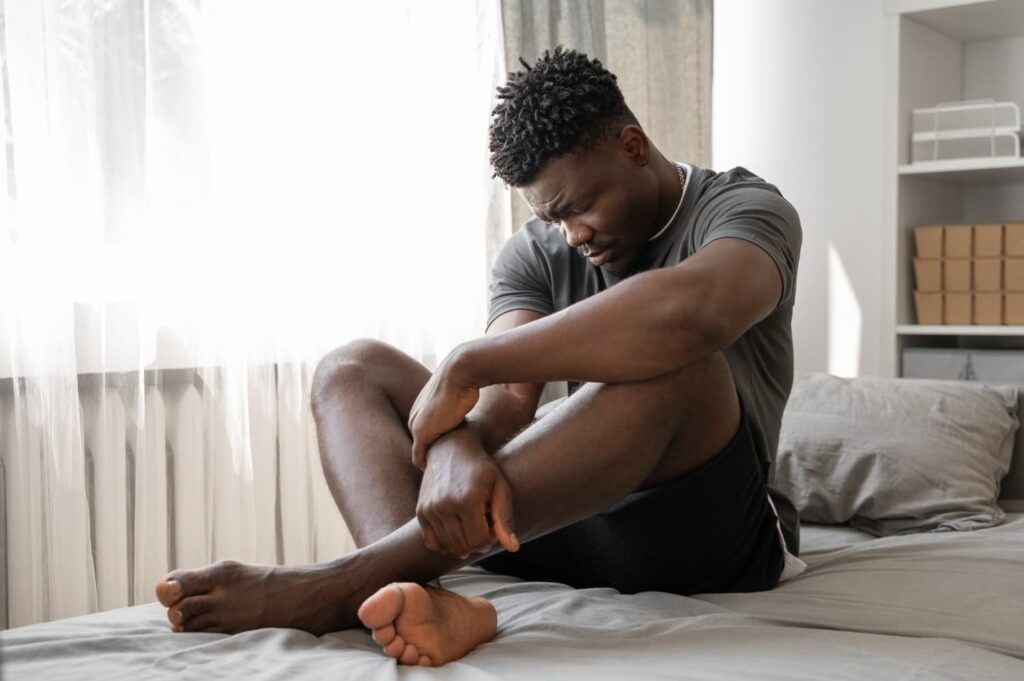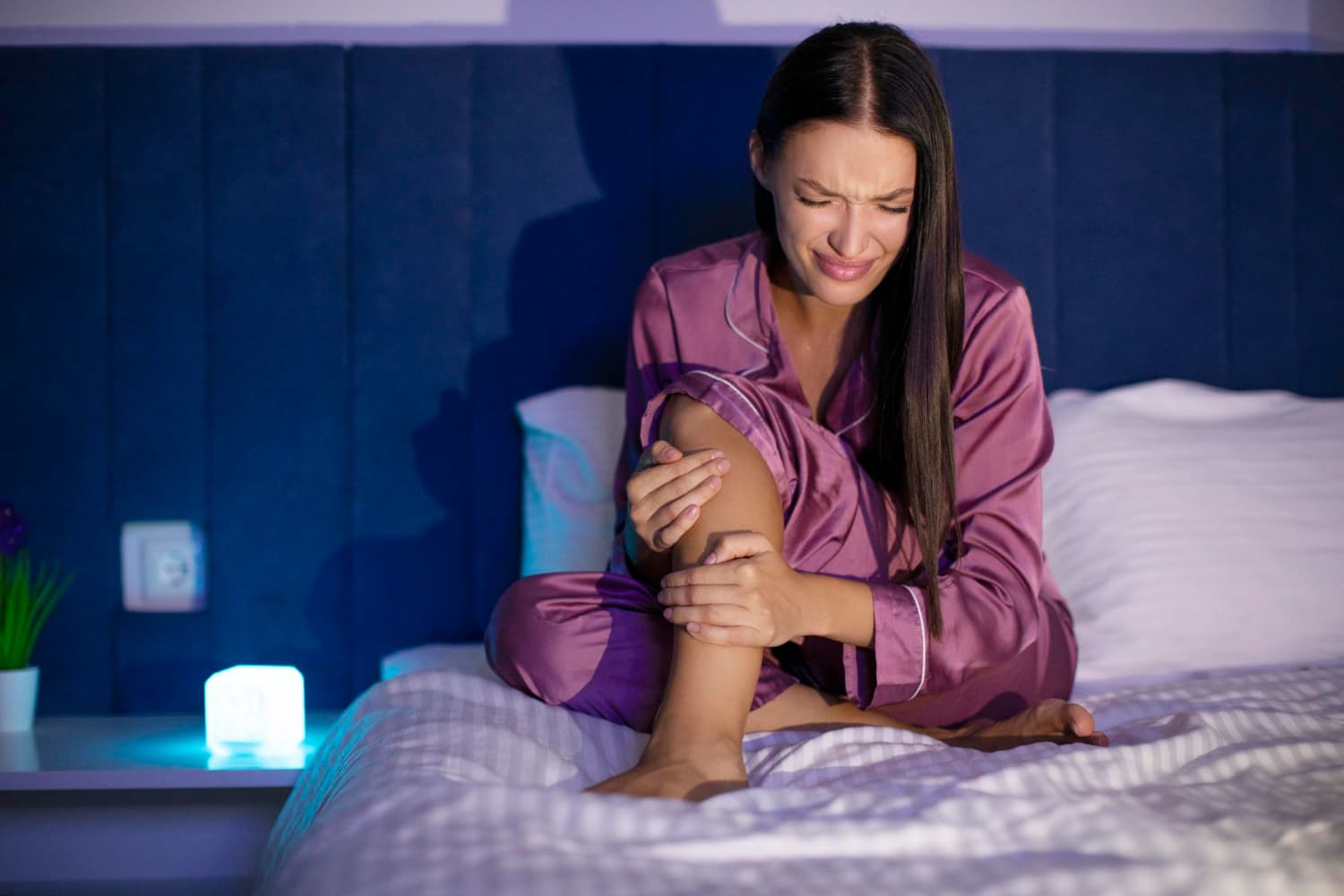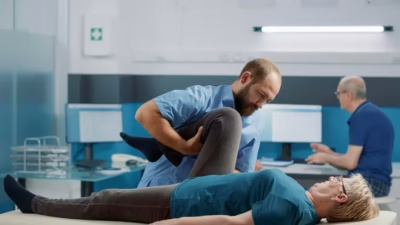Nighttime leg pain is a common issue that disrupts sleep for many people. In fact, 63% of individuals experience irregular calf cramps during the night. In addition, 85% of people report cramps in muscles other than the calves, and 76% of individuals also suffer from muscle cramps during the day while awake. These statistics show just how widespread the problem is, and understanding its causes and remedies can help improve sleep and overall well-being.
This type of leg pain can be caused by various factors, such as muscle fatigue, poor circulation, or even nerve issues. It might also be linked to health conditions like Peripheral Artery Disease (PAD) or Restless Leg Syndrome (RLS). Whatever the cause, nighttime leg pain can impact your daily activities and overall quality of life.
In this post, we’ll explore the common causes of leg pain at night, how it is diagnosed, and the best ways to manage and relieve it. If you often wake up with leg pain or experience discomfort at night, understanding the causes and solutions can help you find the relief you need.
1. Common Causes of Leg Pain at Night
Leg pain at night can happen for many reasons. Understanding the cause of the pain is important so you can find the right relief. Here are the most common causes of leg pain at night and how to manage them.
1.1 Musculoskeletal Pain
Cramps
Leg cramps are one of the most common causes of nighttime leg pain. These cramps are often caused by muscle fatigue, dehydration, or an imbalance in electrolytes. Prolonged periods of sitting or inactivity can also lead to cramps.
How to Manage It:
- Drink plenty of water during the day to stay hydrated.
- Eat foods rich in magnesium and potassium, like bananas and leafy greens.
- Stretch your legs before bed to prevent muscle cramps.
- Consider taking magnesium supplements if needed.
Inflammation of Muscles/Tendons
Sometimes, muscles or tendons become inflamed during sleep, especially if you’ve overused them during the day. This inflammation can lead to discomfort, aches, or pain.
How to Manage It:
- Use anti-inflammatory medication like ibuprofen to reduce swelling.
- Apply heat or cold packs to the sore area for relief.
- Sleep in a comfortable position to avoid putting extra pressure on your legs.
Bone Fractures
Trauma, like a fall or injury, can cause fractures in the bones of your legs. If the bone has not healed properly, you might feel sharp pain, especially at night when you’re resting.
How to Manage It:
- Rest the affected leg to avoid further injury.
- Use anti-inflammatory medication to reduce pain and swelling.
- Seek medical attention right away to ensure proper treatment.
1.2 Circulation-Related Pain
Blood Clots (Deep Vein Thrombosis)
Blood clots can form in your veins, causing swelling, redness, and throbbing pain, especially in one leg. This condition can be serious and needs immediate attention.
How to Manage It:
- If you suspect a blood clot, seek medical help immediately.
- Doctors may recommend blood thinners to prevent the clot from growing.
Varicose Veins
Varicose veins occur when blood doesn’t flow properly through your veins, leading to swelling, pain, and heaviness in your legs. This problem is often worse at night.
How to Manage It:
- Elevate your legs whenever possible to improve circulation.
- Wear compression stockings to help reduce swelling.
- Stay active with regular exercise, like walking, to keep your blood flowing well.
- Consult your doctor for advice on managing varicose veins.
Peripheral Artery Disease (PAD)
PAD occurs when the arteries in your legs become narrow or blocked, reducing blood flow. It is often linked to smoking, diabetes, or high cholesterol. This condition can cause cramping, pain, and discomfort at night.
How to Manage It:
- Make lifestyle changes like quitting smoking and eating a healthy diet.
- Take prescribed medications to improve circulation and control cholesterol.
- For severe PAD, doctors may recommend procedures like angioplasty to restore blood flow.
1.3 Nerve-Related Pain
Peripheral Neuropathy
Peripheral neuropathy is nerve damage that can happen due to diabetes, alcohol use, or other conditions. It causes tingling, burning, numbness, or sharp pain in your legs, especially at night.
How to Manage It:
- Talk to your doctor about medications to relieve nerve pain.
- Gentle movements and leg exercises can improve circulation.
- Keep your blood sugar levels under control if you have diabetes.
Restless Leg Syndrome (RLS)
Restless Leg Syndrome (RLS) causes an uncontrollable urge to move your legs, usually at night. It’s often linked to low dopamine levels or iron deficiency. It can make it hard to relax or sleep.
How to Manage It:
- Iron supplements can help if you have low iron levels.
- Medications may be prescribed to manage symptoms.
- Try stretching your legs before bed to reduce discomfort.
- Establish a regular sleep routine to help calm your legs.
1.4 Other Medical Conditions
Gout
Gout is a type of arthritis caused by urate crystals that build up in your joints, causing pain and swelling. It can be triggered by eating foods high in purines, like red meat and alcohol.
How to Manage It:
- Medications prescribed by your doctor can help reduce pain and swelling.
- Avoid high-purine foods to prevent flare-ups.
- Regular checkups with your healthcare provider can help manage chronic gout.
Pregnancy-Related Pain
Pregnancy can cause leg pain due to increased blood volume, extra weight, and pressure on your veins. You may experience swelling, cramps, and discomfort, especially in the later stages of pregnancy.
How to Manage It:
- Stretch your legs and perform light exercises to reduce swelling.
- Massaging your legs gently can help improve circulation.
- Wear supportive footwear and consider using custom orthotics for extra comfort.
2. Why Leg Pain is Worse at Night

Leg pain can feel much worse at night. There are a few reasons why this happens, and understanding them can help you manage the discomfort better. Let’s take a look at why leg pain often becomes more intense as you try to sleep.
Reduced Circulation
At night, your body’s blood pressure naturally drops, and your blood flow becomes slower. This can make it harder for your legs to get the oxygen and nutrients they need, causing pain. The reduced circulation can make existing conditions, like Peripheral Artery Disease (PAD), feel worse. Poor circulation means your muscles and tissues don’t get the support they need, leading to more discomfort at night.
How to Help:
- Try elevating your legs before bed to improve blood flow.
- Gentle leg exercises during the day can help keep blood flowing properly.
- Wearing compression socks or stockings can support circulation.
Muscle Fatigue
When you’ve been active during the day, your muscles use up oxygen and nutrients. At night, if muscles don’t get enough oxygen, they can cramp or spasm. This is common with muscle fatigue, especially in the calves or thighs. As you lie down, your muscles are at rest, but they might still feel tight or cramp up due to a lack of oxygen and blood flow.
How to Help:
- Stretch your muscles before bed to relax them.
- Stay hydrated throughout the day to keep your muscles from cramping.
- Consider taking magnesium supplements to help with muscle relaxation.
Inactivity
When we sleep or rest for long periods, our muscles and veins stay in one position. This can lead to restricted blood flow, making your legs feel stiff and painful. If you lie in one position for too long, your circulation can slow down, making pain from conditions like varicose veins or PAD even worse.
How to Help:
- Move your legs or do gentle stretching during the night if you wake up with pain.
- Avoid staying in one position for too long while sleeping. Try switching positions to keep blood flowing.
- Simple movements like wiggling your toes or flexing your feet can help.
Increased Pressure
Lying down puts pressure on certain parts of the body, including the legs. This is especially true for people with conditions like PAD or varicose veins. When you lie down, gravity is no longer helping blood return to the heart, and this can cause your veins to swell or your arteries to narrow even more. As a result, you may feel more discomfort or cramping at night.
How to Help:
- Elevate your legs with pillows to help reduce pressure and encourage better circulation.
- Wearing compression stockings can support your veins and reduce swelling.
- Talk to your doctor if you have PAD or varicose veins to explore treatment options that can reduce nighttime pain.
3. Managing and Relieving Leg Pain at Night

Leg pain at night can be bothersome, but there are many ways to relieve it. Whether you’re dealing with cramps, poor circulation, or other discomforts, these tips can help you feel better and sleep more soundly. Here’s how you can manage and relieve leg pain at night.
3.1 Immediate Relief Strategies
Stretching
One of the easiest ways to relieve leg pain is by stretching your muscles before bed. Focus on your calves, hamstrings, and feet. Stretching helps improve flexibility and can prevent muscle cramps. It’s especially helpful if you’ve been on your feet all day or if you tend to get tight muscles at night.
How to Help:
- Stretch your legs gently before going to sleep.
- Hold each stretch for 20-30 seconds to relax your muscles.
Massage
Gently massaging the affected area can help relax muscles and improve blood flow. It’s a simple and effective way to reduce muscle tension or cramping. Use your hands or a foam roller to massage the legs.
How to Help:
- Use circular motions to massage the calves, thighs, or feet.
- You can also use massage oils or creams with soothing scents for extra relief.
Heat or Cold Compresses
Using heat or cold on your legs can also help. Heat can relax stiff muscles, while cold can reduce inflammation if there’s swelling or irritation.
How to Help:
- Apply a warm compress to ease muscle cramps.
- Use an ice pack if you have swelling or inflammation from poor circulation.
Move Around
If your legs start to hurt during the night, try moving around. Walking or simply shifting positions can help get your blood flowing again. Movement can also prevent muscles from locking up, especially if you’ve been in one position for too long.
How to Help:
- Walk around for a few minutes if you wake up with leg pain.
- Try moving your legs gently to help relieve the pressure.
Pain Relievers
Over-the-counter pain relievers like acetaminophen or ibuprofen can help reduce discomfort. These medications are effective in relieving mild to moderate pain and inflammation.
How to Help:
- Take acetaminophen (Tylenol) or ibuprofen (Advil) as directed.
- Talk to your doctor if you need stronger pain relief.
3.2 Lifestyle Modifications for Prevention
Exercise Regularly
Regular exercise is one of the best ways to prevent leg pain. Walking, swimming, or cycling improves circulation and keeps muscles strong. Exercise helps maintain a healthy weight, which can also reduce strain on your legs.
How to Help:
- Aim for 30 minutes of physical activity most days of the week.
- Choose low-impact exercises like swimming or walking to protect your joints.
Hydration
Dehydration can cause muscle cramps, especially at night. Drinking enough water throughout the day helps prevent cramps and keeps your muscles hydrated.
How to Help:
- Drink plenty of water during the day, especially before bed.
- Avoid caffeine or alcohol in the evening, as they can dehydrate you.
Sleep Position
The way you sleep can affect your leg pain. Elevating your legs with pillows can help improve circulation and reduce pressure on your veins. It also helps relieve discomfort from conditions like varicose veins or Peripheral Artery Disease (PAD).
How to Help:
- Place a pillow under your legs to keep them raised while sleeping.
- Try to avoid sleeping with your legs in a position that restricts blood flow.
Proper Footwear
Wearing shoes with good arch support can help reduce strain on your legs. Poor footwear can lead to muscle pain and even conditions like plantar fasciitis. Proper shoes can also prevent leg fatigue, especially if you’re on your feet a lot during the day.
How to Help:
- Choose shoes with good arch support and cushioning.
- Avoid high heels or shoes that don’t offer enough support.
Healthy Diet
Eating a healthy, balanced diet is essential for managing leg pain. Make sure to include foods that are rich in vitamins and minerals, such as magnesium and potassium, which help muscle function.
How to Help:
- Eat a variety of fruits, vegetables, and whole grains.
- Include foods like bananas, spinach, and nuts, which are high in magnesium and potassium.
3.3 Medical Treatments
Medications
If your leg pain is caused by a medical condition like PAD, Restless Leg Syndrome (RLS), or neuropathy, your doctor may prescribe medications. These can include blood thinners for circulation problems, pain relievers, or muscle relaxants.
How to Help:
- Follow your doctor’s recommendations for prescribed medications.
- Take medications as directed to manage your symptoms and prevent nighttime pain.
Physical Therapy
Physical therapy can be helpful if you have muscle weakness or circulation issues. A physical therapist can design exercises to improve blood flow and strengthen your muscles, which can reduce leg pain.
How to Help:
- Work with a physical therapist to develop a program tailored to your needs.
- Perform prescribed exercises regularly to build strength and improve circulation.
Minimally Invasive Procedures
For serious circulation problems like PAD, your doctor may suggest minimally invasive treatments. Procedures like angioplasty or stenting can help restore blood flow to your legs and reduce nighttime pain.
How to Help:
- Talk to your doctor about treatment options if you have PAD or severe circulation problems.
- Minimally invasive procedures can offer relief for long-term circulation issues.
4. When to Seek Professional Help
If you experience leg pain at night, there are times when it’s important to get medical help. While home remedies can be effective for mild discomfort, some symptoms may signal more serious conditions that need professional care. Here are a few signs to watch for.
Persistent Pain
If your leg pain keeps coming back and disrupts your sleep often, it’s time to see a doctor. Pain that doesn’t go away with stretching, movement, or over-the-counter medications might be a sign of an underlying condition, like Peripheral Artery Disease (PAD), nerve damage, or a circulation issue. Chronic leg pain can also point to conditions like Restless Leg Syndrome (RLS) or muscle disorders.
When to Seek Help:
- Leg pain that wakes you up at night regularly.
- Pain that doesn’t improve with home remedies like stretching or hydration.
Swelling or Redness
Swelling, redness, and warmth in your legs could be signs of a blood clot or infection. Blood clots, known as Deep Vein Thrombosis (DVT), can cause serious health risks, including traveling to your lungs. If you notice swelling in one leg, it’s important to get checked by a doctor right away. Infections may cause similar symptoms and also need medical attention.
When to Seek Help:
- One leg becomes swollen, red, and feels warm to the touch.
- You experience pain along with visible swelling.
Nerve Symptoms
If you feel tingling, numbness, or a burning sensation in your legs, and these symptoms don’t improve, it could mean nerve damage. Conditions like peripheral neuropathy, often caused by diabetes or alcohol use, can lead to these symptoms. Nerve pain can be constant or worsened at night, and it’s important to get a diagnosis and treatment.
When to Seek Help:
- Persistent tingling, numbness, or burning sensations in the legs.
- Symptoms that don’t improve or worsen over time.
Difficulty Moving
If leg pain makes it hard to walk or do everyday activities, it’s time to see a healthcare professional. Severe leg pain can limit your ability to move around, which can affect your quality of life. This could be due to muscle, nerve, or joint problems that need medical attention.
When to Seek Help:
- Pain that makes it difficult to walk or perform regular activities.
- If you can’t move your leg due to intense pain or stiffness.
5. Preventing Nighttime Leg Pain
While it’s important to know how to manage leg pain at night, preventing it in the first place is even better. Here are some simple steps you can take to reduce the chances of experiencing leg pain or cramps while you sleep.
Establish a Routine
One of the best ways to prevent nighttime leg pain is by keeping a regular routine. Stretching and exercising during the day can help your muscles stay flexible and strong. Stretch your calves, hamstrings, and feet before bed to avoid muscle cramps. Regular exercise like walking or swimming improves circulation, making it less likely for your legs to feel tight or painful at night.
How to Help:
- Stretch your legs every day, especially before bed.
- Try to exercise regularly to improve blood flow and muscle health.
Manage Underlying Conditions
If you have chronic health conditions like diabetes, high blood pressure, or Peripheral Artery Disease (PAD), it’s important to keep them under control. These conditions can affect circulation, making leg pain more likely. Follow your doctor’s advice to manage your health and prevent complications. Taking medication, eating a healthy diet, and exercising can help keep these conditions in check.
How to Help:
- Follow your doctor’s recommendations for managing conditions like PAD or diabetes.
- Keep your blood sugar and blood pressure levels within a healthy range.
Monitor Diet and Hydration
A well-balanced diet and proper hydration can help prevent leg pain. Make sure to eat foods rich in vitamins and minerals like magnesium and potassium, which help your muscles work properly. Staying hydrated throughout the day can also prevent muscle cramps, which are a common cause of nighttime leg pain.
How to Help:
- Eat a diet full of fruits, vegetables, and whole grains.
- Drink plenty of water to stay hydrated, especially before bed.
Sleep Comfortably
Creating a comfortable sleep environment can help improve your circulation and reduce leg pain. When you sleep, position your legs in a way that promotes healthy blood flow. Elevating your legs with pillows can help relieve pressure and reduce swelling, especially if you have conditions like varicose veins or PAD. Make sure your mattress and pillows provide good support to keep you comfortable all night.
How to Help:
- Use pillows to elevate your legs while sleeping.
- Sleep in a position that allows for good circulation and reduces pressure on your legs.
Conclusion
Leg pain at night is a common problem, but it can be more than just a simple annoyance. It’s often a sign of an underlying health issue like poor circulation, nerve problems, or muscle cramps. The good news is that with the right approach, you can manage this pain and improve your quality of life.
By following prevention strategies such as regular exercise, staying hydrated, and creating a comfortable sleep environment, you can reduce the chances of leg pain at night. Managing underlying conditions like diabetes, Peripheral Artery Disease (PAD), and poor circulation can also make a big difference in preventing discomfort.
If leg pain continues despite these efforts, or if it becomes severe, it’s important to consult a healthcare professional. A doctor can help identify the cause of your leg pain and recommend a treatment plan tailored to your specific needs. This might include medication, physical therapy, or even minimally invasive procedures for conditions like PAD.
If your leg pain persists or becomes severe, it’s important to consult a healthcare professional who can provide a proper diagnosis and treatment plan. You can find qualified specialists in your local area by visiting our listing page for trusted experts near you.
FAQs
What causes leg pain at night?
Leg pain at night can be caused by muscle cramps, poor blood flow (like in PAD), nerve problems, or conditions like Restless Leg Syndrome. Things like dehydration, lack of movement, or bad sleep positions can also cause pain.
How can I stop leg cramps at night?
To stop cramps, try stretching your legs before bed. Drink enough water, eat foods with magnesium and potassium, and exercise regularly. Also, sleep in a good position and raise your legs to improve blood flow.
When should I see a doctor for leg pain at night?
See a doctor if your leg pain doesn’t go away, is very bad, or stops you from sleeping. Also, if you notice swelling, redness, or warmth in one leg, or feel numbness or tingling, it’s a good idea to get checked out.
James Foster, PT is a licensed physical therapist with over 11 years of hands-on experience in helping individuals improve mobility and live pain-free. As a health writer, James shares expert advice, rehabilitation strategies, and wellness tips to empower readers toward healthier, stronger lives.



